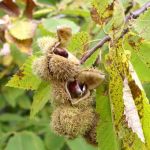| Common Name: |
Sweet Chestnut |
| Other Names: |
Spanish Chestnut |
| Botanical Name: |
Castanea sativa |
| Genus: |
Castanea |
| Family: |
Fagaceae |
| Native Location: |
S Europe, N Africa, SW Asia; widely naturalized. |
| Cultivation: |
Deep, well-drained, neutral to slightly acidic soil in sun or partial shade. |
| Propagation: |
By seed sown in autumn; by budding in summer; by grafting in late winter. |
| Harvest: |
Leaves are gathered in summer and dried for infusions and liquid extracts. Seeds are collected in autumn and cooked before use. |
| Variations: |
Albomarginata syn. Argentomarginata
Has white margined leaves.
Marron de Lyon
Produces fruits with a single kernel, preferred for commercial use. |
| Height: |
30m (100ft) |
| Width: |
15m (50ft) |
| Hardiness: |
Z6-8 |
| Parts Used: |
Leaves, seeds |
| Properties: |
An astringent herb that controls coughing and has anti-rheumatic effects. |
| Medicinal Uses: |
Internally for paroxysmal coughs, whooping cough, excess mucus, diarrhea, and rheumatism (leaves). Externally as a gargle for pharyngitis (leaves). |
| Culinary Uses: |
Chestnuts are used in sauces, soups, stuffings, and desserts, and eaten roasted or boiled as a snack or vegetable. They are also puréed (purée de marrons), crystalized (marrons glacés), ground into flower (farine de châtaigne) for breads and cakes (castagnaccio). Leaves are used to wrap cheeses in France. Chestnut honey is popular in Italy. |
| Bibliography: |
Encylopedia of Herbs by Deni Brown Copyright ©: 1995, 2001 Dorling Kindersley Limited pps. 157-158
|

